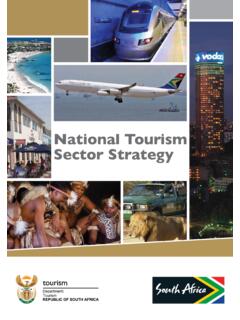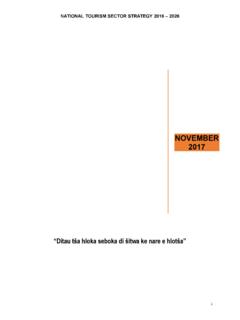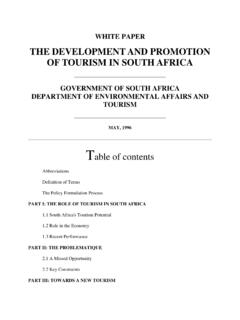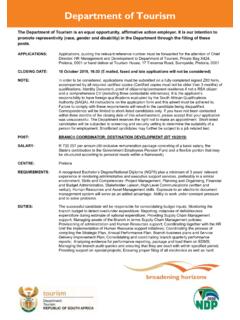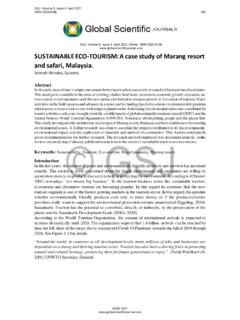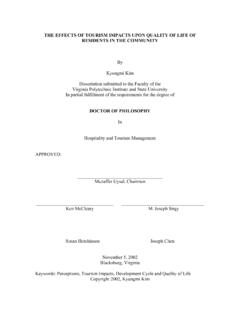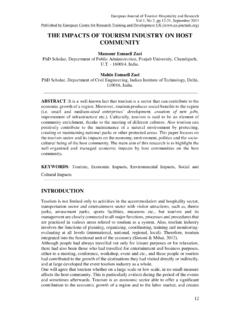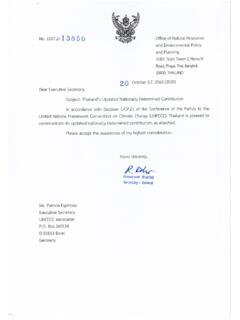Transcription of Tourism Industry Survey of South Africa: COVID-19
1 Tourism Industry Survey of South Africa: COVID-19 Impact, Mitigation and the FutureAPRIL 2020: Survey 12 ForewordTourism is one of South Africa s most important sectors. Last year we received million international Tourism trips and Tourism saw a total injection of billion into the South African economy in Tourism supports 740,000 direct jobs and over million jobs across the economy. The sector is the lifeblood for many micro and small enterprises, often the only economic activity in rural and remote areas, and creates employment opportunities for men, women and youth across the country. We are going through an unprecedented crisis, and there is urgent need to support our existing Industry and plan for longer-term recovery.
2 This Survey is a collaboration between IFC, Department of Tourism , and TBCSA and all its member associations. It aims to quantify the extent of the impact of COVID-19 , how effective the support has been, and what kind of help is still required. We will Survey the Industry three times in total over the next 12 months to track progress. The key findings have been published on the partner s platforms and shared widely with key decision-makers in government, financial institutions and development partners. We hope these insights can inform the effective design of policy and support to your business. Thank you to the 1610 respondents who took the time to complete the Survey , your contribution to the recovery of our sector is much StatsSA Tourism Satellite Account 2019.
3 Blacky Komani Board Chairman, TBCSA3 Highlights 99% of responding firms are affected by COVID-19 . 64% feel neutral or positively believe their business will survive to take part in the recovery. 83% of firms report revenues in March 2020 are down more than 50% compared to March 2019, and 34% of firms say revenues are 100% less. 58% of firms were unable to service their debts and 54% of firms were unable to cover fixed costs in March 2020. Firms so far report having managed their workforce in different ways, with most favoring reduced wages over furlough or redundancies. 50% of firms have reduced wages for more than 50% of staff, and 36% of firms have reduced wages for all staff.
4 11% of firms have made more than 50% of their workforce redundant, and 53% have not made any redundancies. A greater proportion (75%) of medium businesses have reduced wages than small businesses, and a greater proportion (31%) of small businesses have applied redundancies. The most commonly applied mitigation measures by businesses are temporary closure at 69%, supporting deferment instead of cancellation at 60%, and significant downscaling at 58%. All businesses prioritized the need for financial support for cashflow, financial support for recovery, and tax relief. Micro firms claim cashflow is their first priority, small firms prioritize financial support for recovery, and both medium and large firms prioritized tax relief.
5 The support facilities with the most respondent awareness are the UIF scheme and the Tourism Relief Fund of the Department of Tourism . There has been strong uptake for all facilities, but success rates in these early days are uniformly Profile Summary 1610 total respondents. 50% operate in the Western Cape, the remainder across the country. 66% are micro with 1 - 10 employees. 52% have annual turnover of R0 - 3m. 46% are accommodation providers, 20% are tour operators, and the rest split between activity providers, Meetings, Incentives, Conventions and Exhibitions (MICE), conservancy-related, community-based, transport and other. 62% of firms are 10 years or GrowingIn declineStagnant40%28%32%ResultsOverviewB efore COVID-19 , in February 2020, the performance and optimism around the South African Tourism economy was relatively positive.
6 40% of responding firms claim they were growing, with a further 32% performing at a constant level. Most firms felt either neutral or positive about the future of their business and Tourism in South Africa. After the first 6 weeks of feeling the impact of COVID-19 , 99% of firms claim to be affected by the pandemic. Only 23% feel neutral or optimistic about the future. BEFORE COVID-1979% felt neutral or optimistic about their business and the future of Tourism in IN APRIL 202023% feel neutral or optimistic about their business and the future of Tourism in at all Very much 10% 11% 18% 21% 40%64% feel neutral or positively believe their business will survive to take part in the recovery.
7 Not at all Very optimistic 50% 28% 14% 5% 4%Not at all Very optimistic 9% 27% 35% 16% 13%5 0%10%20%30%40%50%60%70%80%90%100%Busines s impact of COVID-19 REVENUE83% of firms report revenues in March 2020 are down more than 50% compared to March 2019, and 34% of firms say revenues are 100% SERVICE58% of firms were unable to service their debts in March COSTS54% of firms were unable to cover fixed costs in March USE85% of firms state occupancy in March 2020 is down more than 50% compared to March 2019, and 47% say occupancies are 100% BOOKINGS81% of firms report forward bookings held in March 2020 are at least 50% less than bookings held in March 2019.
8 And 36% hold 100% fewer 100%Down 50% or moreResponding firmsDown 100%Down 50% or moreDown 100%Down 50% or moreNoYe sI don t knowNot applicable7% 34% 83% 47% 85% 50% 81%0%10%20%30%40%50%60%70%80%90%100%Resp onding firms0%10%20%30%40%50%60%70%80%90%100%Re sponding firms6 SUB-SECTORE nterprises in conservancies, MICE and activity providers have seen the most dramatic loss in revenue, with the accommodation sector seeing the least decline. Conservancies are the worst affected in holding any forward bookings, followed by transport, and accommodation.
9 Tour operators have so far held the most of their forward of firms with more than 50% revenue decline83%83%76%80%83%Average (mean) percentage revenue decline in March 2019, compared to March 2020-72%-70%-63%-62%-71%Accommodation Activity/ experienceCommunity- basedConservancy/ protected areaMICETour operatorTransportOtherTotalAverage (mean) percentage revenue decline March 2019, compared to March 2020-66%-80%-76%-87%-83%-74%-69%-73%-71% Average (mean) forward bookings decline in March 2019, compared to March 2020-72%-71%-83%-73%-70%-66%-73%-69%-70% Business impact: InsightsSIZE OF FIRMM icro and small firms are slightly more affected in terms of loss of revenue, but all sizes are suffering.
10 7 Mitigation measuresEmployment measuresFirms so far report having managed their workforce in different ways, with most favoring reduced wages over furlough or redundancies. Most firms have directed their attentions to either all or just ten percent of the WAGES50% of firms have reduced wages for more than 50% of staff, and 36% of firms have reduced wages for all staff. 18%, however, have not reduced wages at of firms have made more than 50% of staff redundant, and 7% of firms made all staff redundant. 53%, however, have not made any STAFF32% of firms have furloughed more than 50% of staff, and 18% of firms have furloughed all staff.

